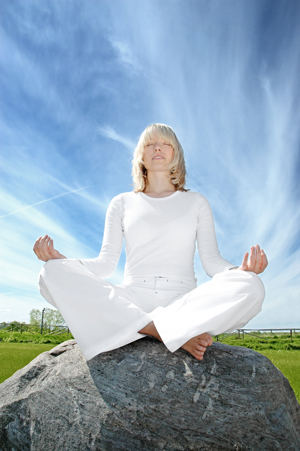by Kathleen Bryant —
Many yoga practitioners begin with asana, the physical postures of Hatha Yoga. Gradually, as asana opens the physical body, a person’s mind and heart open and there is a desire to expand “the yoga zone” into other areas of life. Philosopher Pierre Teilhard de Chardin said, “We are not human beings having a spiritual experience; we are spiritual beings having a human experience.”
This realization — discovering our true nature as spiritual beings — is the path to perfection. And as your mother, your typing teacher, your softball coach always said: “Practice makes perfect.”
Daily spiritual practice, or sadhana, is a means of self-knowledge and growth. Sadhana may include pranayama or breath awareness; asana — such as surya namaskara, the sun salutation; and meditation or prayer, perhaps a mantra for personal healing or a blessing for all beings. Because yoga is a practice, not a religion, a yoga sadhana can incorporate whatever it is that touches the individual heart: prayer or chant, a statue of Lakshmi or a photograph of your grandmother.
The best time for sadhana is early morning, during the sweet quiet before dawn. This is brahmamuhurta, the time considered most auspicious for prayers and meditation. The mind has not yet turned to the cares of the day, and the powerful unconscious of dreamtime is still nearby.
It is good to establish a place for your sadhana, near a personal altar or perhaps underneath your favorite pine tree. Over time, this space will become charged with the intention and energies of your practice. Choose a time period and commit to it — better 15 minutes every day than an hour every now and then. Though a little variation in practice is fine, it is through daily repetition and routine that we begin to build awareness.
The benefits are exponential; daily sadhana becomes an underlying support structure or touchstone for the rest of the day. As we move farther down the path of perfection, many old habits and desires drop away. The mind becomes calm and quiet, the ego or “monkey mind” less insistent. True relaxation becomes easier, and we develop an inner strength that sustains us through the demands of modern life.
Kathleen Bryant teaches postnatal and therapeutic yoga and assists with teacher training at 7 Centers Yoga Arts in Sedona, Ariz. 928-203-4400 or www.7centers.com.
Reprinted from AzNetNews, Volume 25, Number 3, June/July 2006.






January 31, 2013
Meditation, Spiritual, Philosophical and Metaphysical, Yoga